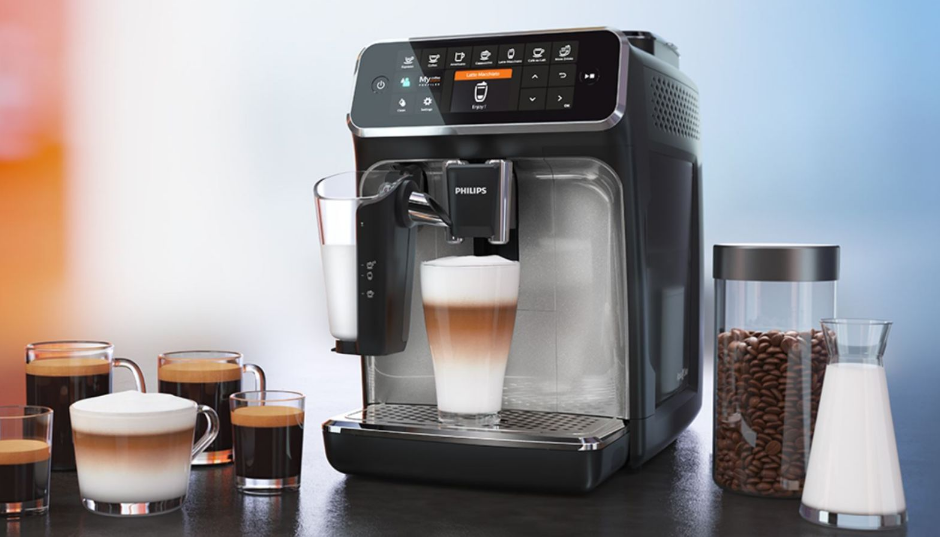
PHILIPS 4300 Series Fully Automatic Espresso Machine
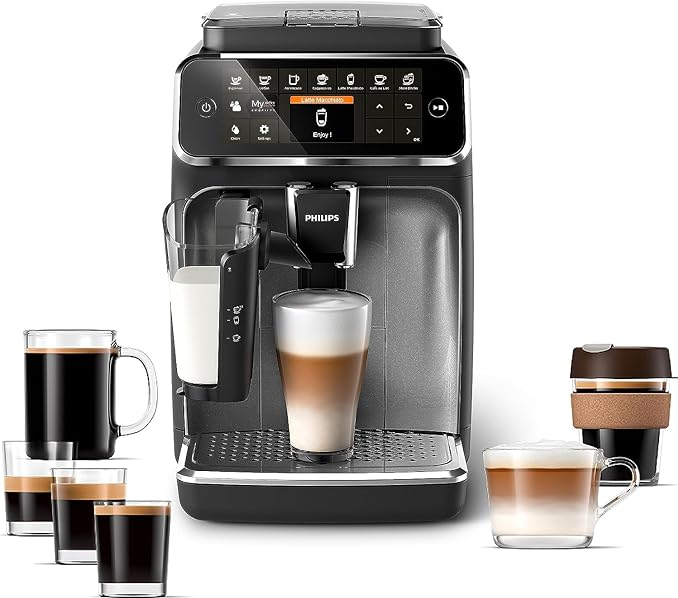
Machine overview
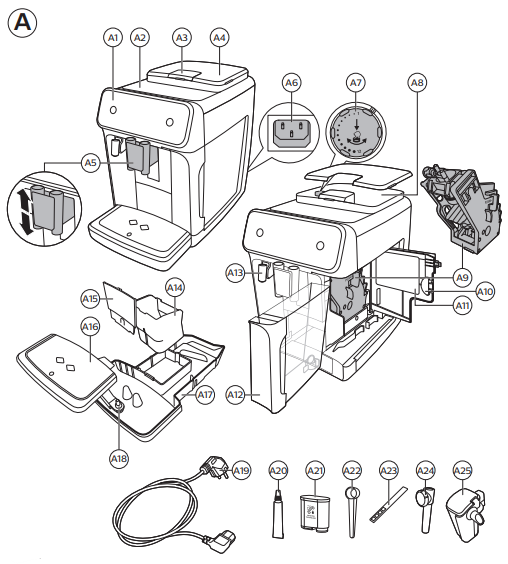
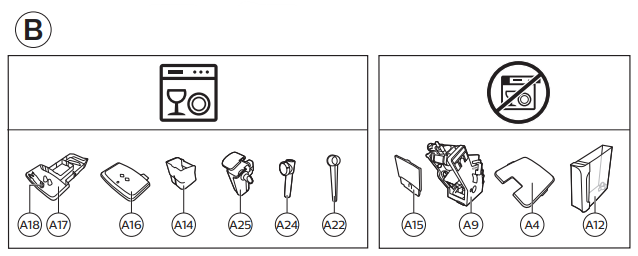
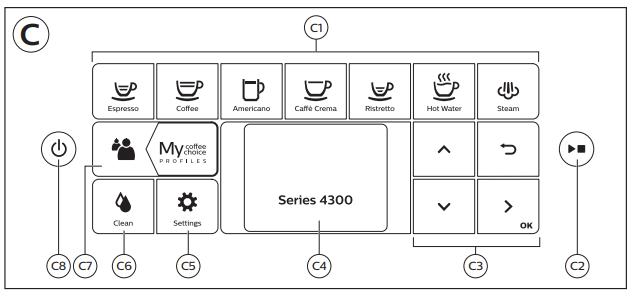

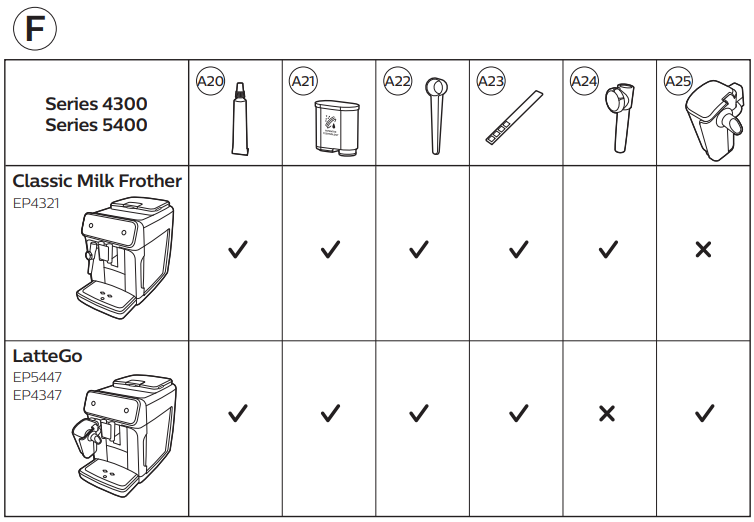
Machine overview (Fig. A)
- A1 Control panel
- A2 Cup holder
- A3 Pre-ground coffee compartment
- A4 Lid of bean hopper
- A5 Adjustable coffee spout
- A6 Socket for power cord
- A7 Grind setting knob
- A8 Coffee bean hopper
- A9 Brew Group
- A10 Service door
- A11 Data label with type number
- A12 Water tank
- A13 Hot water spout
- A14 Coffee grounds container
- A15 Front panel of coffee grounds container
- A16 Drip tray cover
- A17 Drip tray
- A18 ‘Drip tray full’ indicator
Accessories
- A19 Power cord
- A20 Grease tube
- A21 AquaClean water filter
- A22 Measuring scoop
- A23 Water hardness test strip
- A24 Classic milk frother (specific types only)
- A25 LatteGo (milk container) (specific types only)
Control panel
There are multiple versions of this espresso machine, with different control panels. Each version has its type number. You can find the type number on the data label on the inside of the service door (Fig. A11). You can also find the type number by tapping the Settings ![]() icon and selecting ‘Support’.
icon and selecting ‘Support’.
Refer to figures C, D, and E for an overview of all buttons and icons. Below you find the description.
Use the up and down arrows to scroll through the display and tap the OK icon to select or confirm your choices.
All types (Fig. C/D/E)

EP4321 only (Fig. C)
C1 One-touch drink icons: Espresso, Coffee, Americano, Caffé Crema, Ristretto, Hot Water, and Steam
EP4347 only (Fig. D)
D1 One-touch drink icons: Espresso, Coffee, Americano, Cappuccino, Latte Macchiato
EP5447 only (Fig. E)
E1 One-touch drink icons: Espresso, Coffee, Americano, Cappuccino, Latte Macchiato
Introduction
Congratulations on your purchase of a Philips fully automatic coffee machine! To fully benefit from the support that Philips offers, register your product at www.philips.com/ registeryourcoffee.com or by scanning the QR code (Fig. 1) in this booklet.
Read the separate safety booklet carefully before you use the machine for the first time and save it for future reference.
To help you get started and get the best out of your machine, Philips offers support in multiple ways. In the box, you find:
- This user manual with picture-based usage instructions and more detailed information on cleaning and maintenance.
- The separate safety booklet with instructions on how to use the machine in a safe way.
- For online support (frequently asked questions, movies, etc.), scan the QR code on the cover of this booklet or visit https://www.usa.philips.com/c-m-ho/coffee/your-philipsespresso- machine. You can also find the QR code by tapping the Settings icon and selecting Support.
This machine has been tested with coffee. Although it has been carefully cleaned, there may be some coffee residue left. We guarantee, however, that the machine is new.
The machine automatically adjusts the amount of ground coffee that is used to make the best-tasting coffee. You should brew 5 coffees initially to allow the machine to complete its self-adjustment. Make sure you rinse the LatteGo (milk container) or the classic milk frother before first use.
Before first use


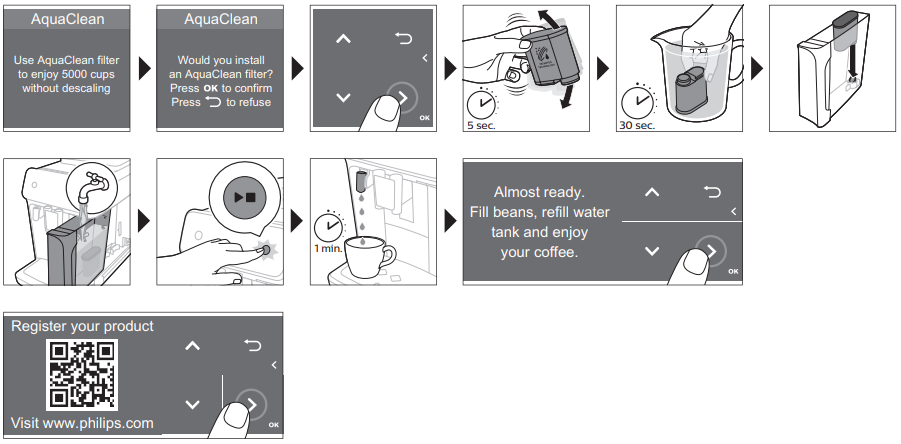
Assembling LatteGo (specific types only)

Assembling the classic milk frother (specific types only)

Brewing drinks
General steps
- Fill the water tank with tap water and fill the bean hopper with beans.
- Insert the small plug into the socket located on the back of the machine. Insert the mains plug into the wall socket.
- Press the on/off button to switch on the machine.
- The machine starts heating up and performs the automatic rinsing cycle.
- When all lights in the drink icons light up continuously, the machine is ready for use.
- Place a cup under the coffee dispensing spout. Slide the coffee dispensing spout up or down to adjust its height to the size of the cup or glass you are using (Fig. 2).
Brewing coffee with beans
- To brew a coffee, tap the drink icon of your choice (Fig. 3) or tap the ‘More Drinks’ icon (Fig. 4) (specific types only).
- You can now adjust the drink to your taste (Fig. 5). Use the up and down arrows (Fig. 6) to adjust the coffee strength. Tap the OK icon if you want to adjust more settings (Fig. 7).
- Press the start/stop
 button at any time to start brewing the selected drink.
button at any time to start brewing the selected drink. - To stop dispensing coffee before the machine is finished, press the start/stop
 button again.
button again.
To brew 2 coffees at the same time, tap the drink icon twice or select the 2x icon scrolling the dedicated bar.
![]() Do not use caramelized or flavored coffee beans.
Do not use caramelized or flavored coffee beans.
Brewing milk-based drinks with LatteGo (milk container)
LatteGo consists of a milk container, a frame, nd a storage lid. To avoid leakage, make sure the frame and the milk container are properly assembled before you fill the milk container.
- To assemble LatteGo, first, insert the top of the milk container under the hook at the top of the frame (Fig. 8). Then, press home the bottom part of the milk container. You hear a click when it locks into place (Fig. 9).
Note: Make sure that the milk container and the frame are clean before you connect them. - Slightly tilt LatteGo and put it on the hot water spout (Fig. 10). Then press it home until it locks into place (Fig. 11).
- Fill LatteGo with milk (Fig. 12). Do not fill the milk container beyond the maximum indication.
If you have personalized the milk quantity, you may need to fill the milk container with
more or less milk than indicated for this drink on LatteGo.
Always use milk coming directly from the fridge for optimal results. - Place a cup on the drip tray.
- Tap the milk-based drink icon of your choice or tap the ‘More Drinks’ icon (specific types only) to select a different drink (see ‘Personalizing drinks’)
– You can now adjust the drink to your preference - Press the start/stop
 button.
button.- When you brew a cappuccino, a flat white latte macchiato, the machine first dispenses milk and then coffee. When you brew caffè latte or café au lait, the machine first dispenses coffee and then milk.
- To stop dispensing milk before the machine has dispensed the preset amount, press the start/stop
 button.
button.
- To stop dispensing the complete drink (milk and coffee) before the machine is finished, press and hold the start/stop
 button.
button.
Frothing or heating milk with a classic milk frother
Always use milk coming directly from the fridge for the best foam quality.
- Tilt the black silicone handle on the machine to the left and slide the milk frother onto it (Fig. 13).
- Fill a milk jug with approximately. 100 ml milk for a cappuccino and approx. 150 ml milk for latte macchiato.
- Insert the milk frother approx. 1 cm into the milk.
- Tap the steam icon (Fig. 14).
- Turn the knob on the classic milk frother to the milk frothing icon (Fig. 15) if you want to froth milk. Turn the knob on the classic milk frother to the flat milk icon (Fig. 16) if you want to heat up milk.
- Make sure that the icon on the knob of the classic milk frother is aligned with the black arrow.
- Press the start/stop
 button to start (Fig. 17).
button to start (Fig. 17).- The machine starts heating up, steam is forced into the milk and the milk is either frothed or heated.
- When the milk in the milk jug has reached the required foam volume or heat, press the start/stop
 button again to stop frothing/heating milk.
button again to stop frothing/heating milk.
Never steam milk longer than 90 seconds. The steaming automatically stops after 90 seconds.
In order to get the best milk froth quality, you do not have to move the milk jug during milk frothing.
Extra shot (ExtraShot) (specific types only)
Your machine offers you the possibility to add an extra shot of Ristretto to your coffee and milk drinks, for example, if you want to have a stronger coffee.
- Place a cup under the spout..
- Tap one of the one-touch drinks icons to select a drink or tap the ‘More Drinks’ icon (specific types only) to select a drink.
- Use the up arrow to set the strength to the top level and then select the ExtraShot function (Fig. 18).
- Tap the OK icon if you want to personalize the other settings. Then press the start/stop
 icon to start brewing the drink.
icon to start brewing the drink. - To stop dispensing the drink before the machine has finished, press the start/stop
 icon again.
icon again.
When you have selected the ExtraShot function, you can only brew one coffee at a time.
Brewing coffee with pre-ground coffee
You can choose to use pre-ground coffee instead of beans, for example, if you prefer a different coffee variety or decaffeinated coffee.
- Open the lid of the pre-ground coffee compartment and pour one leveled measuring scoop of pre-ground coffee into it (Fig. 19). Then close the lid.
- Tap one of the one-touch drink icons or tap the ‘More Drinks’ icon (specific types only) to select another drink.
- Select the pre-ground coffee function. You can do this in 2 different ways:
- Use the down arrow to set the strength to the lowest level and then select the pre-ground function.
- Press the Settings
 icon and use the down arrow to select the pre-ground function.
icon and use the down arrow to select the pre-ground function.
- To stop dispensing coffee before the machine has finished, press the start/stop
 button again.
button again.
When you select the pre-ground coffee function:
- It is automatically stored.
- You can only brew one coffee at a time.
- You cannot select a different aroma strength.
Dispensing hot water
- If attached, remove LatteGo or the milk frother.
- Place a cup under the hot water spout.
- Tap the ‘Hot Water’ icon (specific types only) or tap the ‘More Drinks’ icon (specific types only) (Fig. 4) to select hot water.
- Use the up and down arrows to adjust the hot water quantity and/or temperature to your preference.
- Press the start/stop
 button.
button.- Hot water is dispensed from the hot water spout (Fig. 20).
- To stop dispensing hot water before the machine is finished, press the start/stop
 button again.
button again.
Personalizing drinks
The machine allows you to adjust the settings of a drink to your preference and to store the adjusted drink in a personal profile. The different profiles have different colors.
After selecting a drink by tapping one of the one-touch drink icons or by tapping the ‘More Drinks’ icon (specific types only), you can do the following things:
- Adjust the aroma strength with the up and down icons (Fig. 21). There are 5 strengths, the lowest is the mildest and the highest is the strongest.
- Adjust the coffee quantity (Fig. 22) and/or the milk quantity (specific types only) with the up and down icons. There are 5 quantities for each of the settings.
As soon as the machine has finished brewing, the settings you selected will be stored automatically in the profile you chose.
Select a profile
You can select a profile and store a recipe using My Coffee Choice profiles (My Coffee Choice Profiles).
- Tap the profiles
 icon repeatedly to select one of the colored profiles. All profiles have a different color.
icon repeatedly to select one of the colored profiles. All profiles have a different color. - Select a drink by tapping one of the one-touch drink icons or by tapping the ‘More Drinks’ icon (specific types only).
- Adjust the drink settings to your favorite taste.
- Press the start/stop
 button to brew the drink you selected
button to brew the drink you selected- Your new settings have now been stored in the colored profile you selected.
You can always restore the factory settings of the machine (see ‘Restoring factory settings’).
Guest profile
Your machine is equipped with a guest profile. When the guest profile is selected, the profile icon is off. When you select this profile, you can still personalize the settings to your preference, but the recipes you brew will not be stored.
Adjusting machine settings
Setting the water hardness
We advise you to adjust the water hardness setting to the water hardness level in your region for optimal performance and a longer lifetime for the machine. This also prevents you from having to descale the machine too often. The default water hardness setting is 4: hard water.
Use the water hardness test strip supplied in the box to determine the water hardness in your region.
- Immerse the water hardness test strip in tap water or hold it under the tap for 1 second (Fig. 23).
- Wait 1 minute. The number of squares on the test strip that turn red indicates the water hardness (Fig. 24).
Set the machine to the correct water hardness.s
- Tap the Settings
 icon and use the up and down arrows to select ‘Water hardness’. Then press the OK icon to confirm.
icon and use the up and down arrows to select ‘Water hardness’. Then press the OK icon to confirm. - Use the up and down icons to select the water hardness level. The number of red squares selected on the display should be the same as the number of red squares on the test strip (Fig. 25).
- When you have set the correct water hardness, tap the OK icon to confirm.
Adjusting grinder settings
You can change the coffee strength with the grind setting knob inside the bean container. The lower the grind setting, the finer the coffee beans are ground and the stronger the coffee. There are 12 different grind settings you can choose from.
The machine has been set up to get the best taste out of your coffee beans. Therefore we advise you not to adjust the grinder settings until you have brewed 100-150 cups (approx. 1 month of use).
You can only adjust the grind settings when the machine is grinding coffee beans. You need to brew 2 to 3 drinks before you can taste the full difference.
Do not turn the grind setting knob more than one notch at a time to prevent damage to the grinder.
- Place a cup under the coffee dispensing spout.
- Open the lid of the coffee bean hopper.
- Tap the espresso icon and then press the start/stop
 button.
button. - When the grinder starts grinding, press down the grind setting knob and turn it to the left or right. (Fig. 26)
Adjusting other machine settings
By tapping the Settings![]() icon, you can adjust the following machine settings:
icon, you can adjust the following machine settings:
- Water hardness: you can select between 5 levels according to the water hardness in your region;
- Standby time: You can select 15, 30, 60, or 180 minutes
- Display brightness: You can select low, medium, and high.
- Language
- Sound: you can activate or deactivate the beeping sound of the machine
- Temperature: you can choose between 3 brewing temperatures for your coffee
- Front illumination (specific types only): you can choose ‘always on’, ‘on during brewing’, or ‘always off’.
- Measuring unit: you can choose between ml. or oz.
Restoring factory settings
The machine offers you the possibility to restore the factory settings at any moment.
- Tap the Settings
 icon.
icon. - Use the up and down icons to select ‘Factory settings’. Confirm by tapping the OK icon.
- Press the start/stop
 button to confirm you want to restore the settings.
button to confirm you want to restore the settings.- The settings are now being restored.
The following factory settings are restored to default: water hardness, standby time, display brightness, sound, temperature, front illumination, and profiles.
Removing and inserting the brew group
Go to https://www.usa.philips.com/c-m-ho/coffee/your-philips-espresso-machine for detailed video instructions on how to remove, insert, and clean the brew group.
Removing the brew group from the machine
- Switch off the machine.
- Remove the water tank and open the service door (Fig. 27).
- Press the PUSH handle (Fig. 28) and pull at the grip of the brew group to remove it from the machine (Fig. 29).
Reinserting the brew group
![]() Before you slide the brew group back into the machine, make sure it is in the correct position.
Before you slide the brew group back into the machine, make sure it is in the correct position.
- Check if the brew group is in the correct position. The arrow on the yellow cylinder on the side of the brew group has to be aligned with the black arrow and N (Fig. 30).
- If they are not aligned, push down the lever until it is in contact with the base of the brew group (Fig. 31).
- Slide the brew group back into the machine along the guiding rails on the sides (Fig. 32) until it locks into position with a click (Fig. 33). Do not press the PUSH button.
- Close the service door and place back the water tank.
Cleaning and maintenance
Regular cleaning and maintenance keep your machine in top condition and ensure tastinggg coffee for a long time with a steady coffee flow.
Consult the table below for a detailed description of when and how to clean all detachable parts of the machine. You can find more detailed information and video instructions at https://www.usa.philips.com/c-m-ho/coffee/your-philips-espresso-machine. See Figure B for an overview of which parts can be cleaned in the dishwasher.
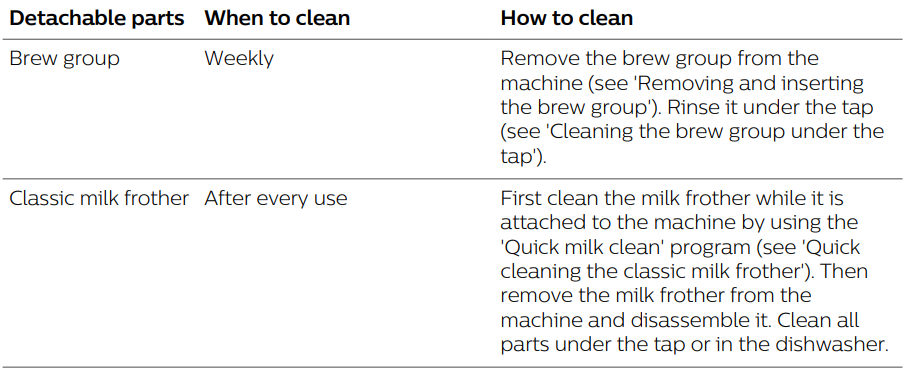

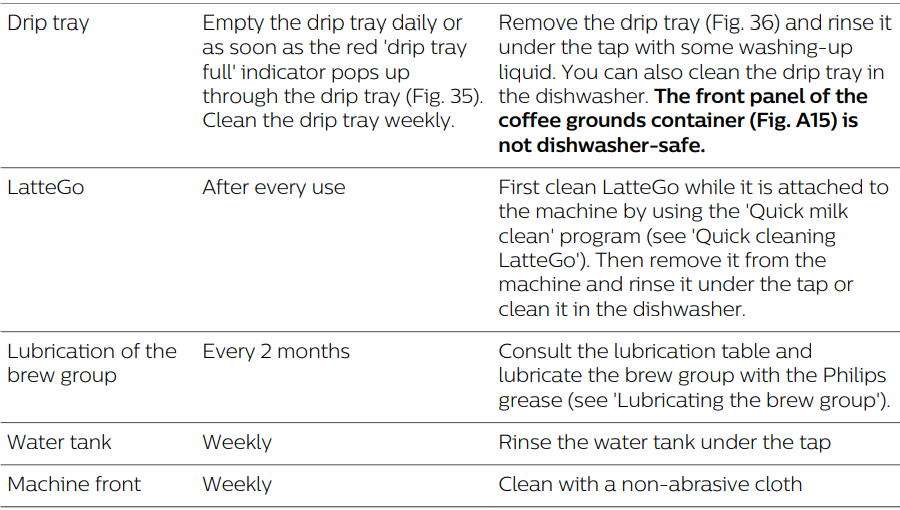
Cleaning the brew group
Regular cleaning of the brew group prevents coffee residues from clogging up the internal circuits. Visit https://www.usa.philips.com/c-m-ho/coffee/your-philips-espresso-machine for support videos on how to remove, insert, and clean the brew group.
Cleaning the brew group under the tap
- Remove the brew group (see ‘Removing and inserting the brew group’).
- Rinse the brew group thoroughly with water. Carefully clean the upper filter (Fig. 37) of the brew group.
- Let the brew group air-dry before you place it back. Do not dry the brew group with a cloth to prevent fibers from collecting inside the brew group.
Lubricating the brew group
To improve your machine’s performance, we suggest that you lubricate the brew group every 2 months, to ensure that the moving parts continue to move smoothly.
- Apply a thin layer of grease on the piston (grey part) of the brew group (Fig. 38).
- Apply a thin layer of grease around the shaft (grey part) at the bottom of the brew group (Fig. 39).
- Apply a thin layer of grease to the rails on both sides (Fig. 40).
Cleaning LatteGo (milk container) (specific types only)
Quick cleaning LatteGo
- Make sure LatteGo is properly attached to the machine (Fig. 10).
- Place a cup under the spout.
- Tap the Clean
 icon and use the up and down arrows to select the ‘Quick Milk Clean’ program.
icon and use the up and down arrows to select the ‘Quick Milk Clean’ program. - Tap the OK icon to confirm and then follow the instructions on the screen to remove any milk that may be left inside the milk system.
- Small jets of hot water will be dispensed by the milk system.
- Store LatteGo with the remaining milk in the fridge.
Thoroughly cleaning LatteGo
- Remove LatteGo from the machine (Fig. 41).
- Pour out any remaining milk.
- Press the release button and remove the milk container from the frame of LatteGo (Fig. 42).
- Clean all parts in the dishwasher or under the tap with lukewarm water and some washing-up liquid.
Cleaning the classic milk frother (specific types only)
Quick cleaning of the classic milk frother
- Make sure the classic milk frother is properly attached to the machine (Fig. 13).
- Place a cup under the spout.
- Tap the Clean
 icon and use the up and down arrows to select the ‘Quick Milk Clean’ program.
icon and use the up and down arrows to select the ‘Quick Milk Clean’ program. - Tap the OK icon to confirm and then follow the instructions on the screen to remove any milk that may be left inside the milk frother.
- Small jets of hot water will be dispensed by the milk system.
- Clean the milk frother with a damp cloth.
Daily cleaning of the classic milk frother
- Let the milk frother cool down completely.
- Tilt the milk frother to the left and remove the metal part and the silicone part (Fig. 43).
- Disassemble the three parts (Fig. 44) and rinse them with fresh water or clean them in the dishwasher.
- Reassemble the three milk frother parts and reattach the milk frother to the machine.
AquaClean water filter
Your machine is AquaClean enabled. You can place the AquaClean water filter in the water tank to preserve the taste of your coffee. It also diminishes the need for descaling by reducing limescale build-up in your machine. You can purchase an AquaClean water filter from your local retailer, from authorized service centers, or online atwww.philips.com/parts-and accessoriess.
AquaClean filter status indication
When the AquaClean is active, the status of the AquaClean filter is always visible on the screen as a percentage.
- If the status of the AquaClean filter is 10% or less, the screen shows a message for 2 seconds each time you switch on the machine. This message advises you to buy a new filter.
- If the status of the filter is 0%, the machine asks you to replace the AquaClean filter every time you switch on the machine.
Troubleshooting
This chapter summarizes the most common problems you could encounter with the machine. Support videos and a complete list of frequently asked questions are available at https://www.usa.philips.com/c-e/ho/coffee/coffee-troubleshooting.html. If you are unable to solve the problem, contact the Consumer Care Center in your country. For contact details, see the warranty leaflet.
Warning icons
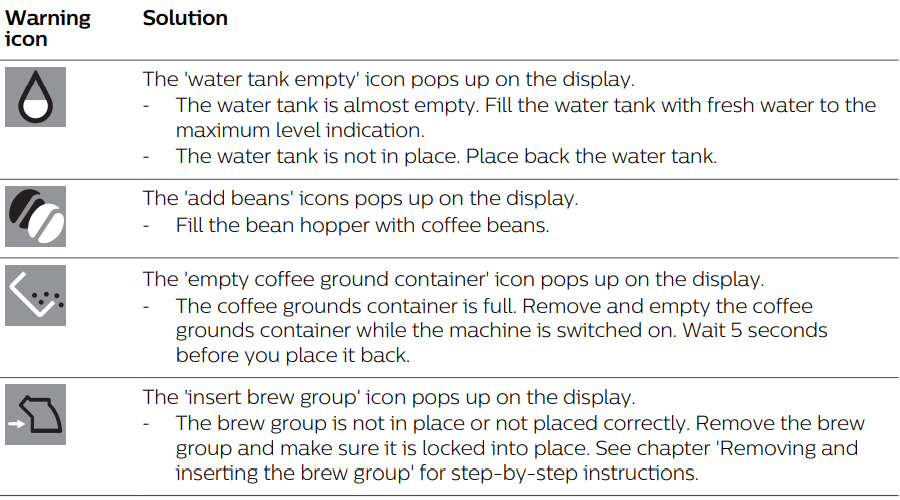
Error codes
Below you find a list of the error codes showing problems that you can solve yourself. Video instructions are available at https://www.usa.philips.com/c-m-ho/coffee/your-philipsespresso-machine. If another error code appears, please contact the Philips Consumer Care Center in your country. For contact details, see the warranty leaflet.
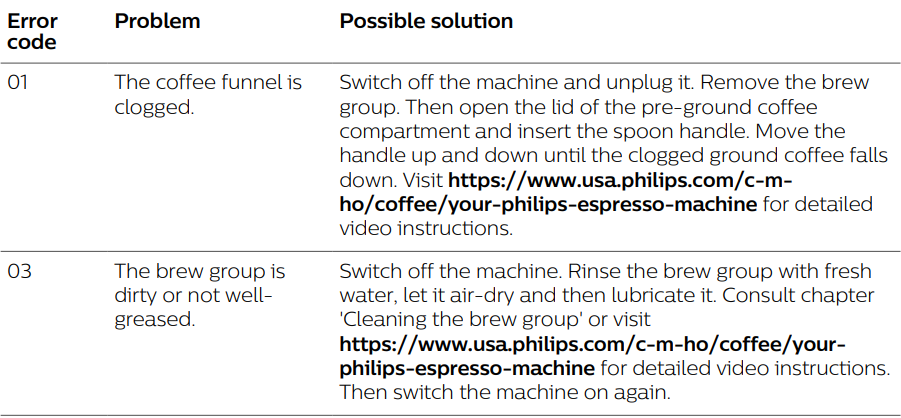
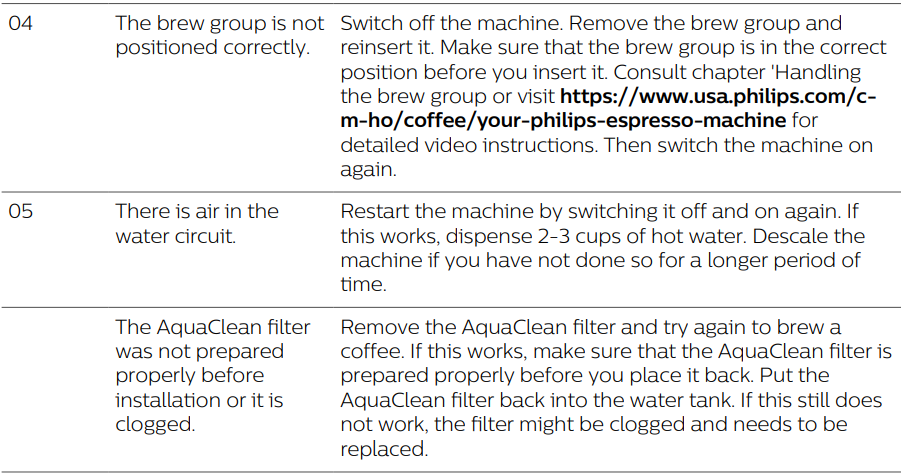

Troubleshooting table
This chapter summarizes the most common problems you could encounter with the machine. Support videos and a complete list of frequently asked questions are available at https://www.usa.philips.com/c-e/ho/coffee/coffee-troubleshooting.html. If you are unable to solve the problem, contact the Consumer Care Center in your country. For contact details, see the warranty leaflet.


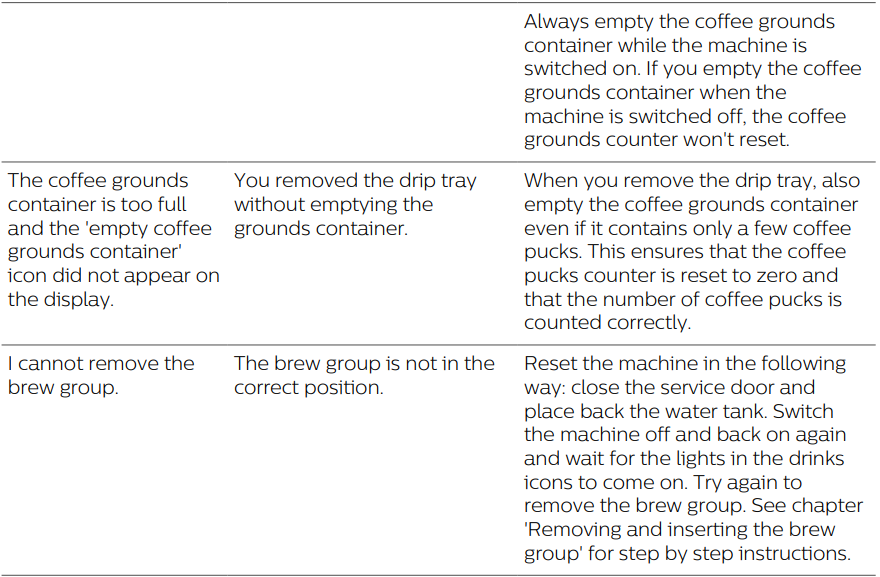
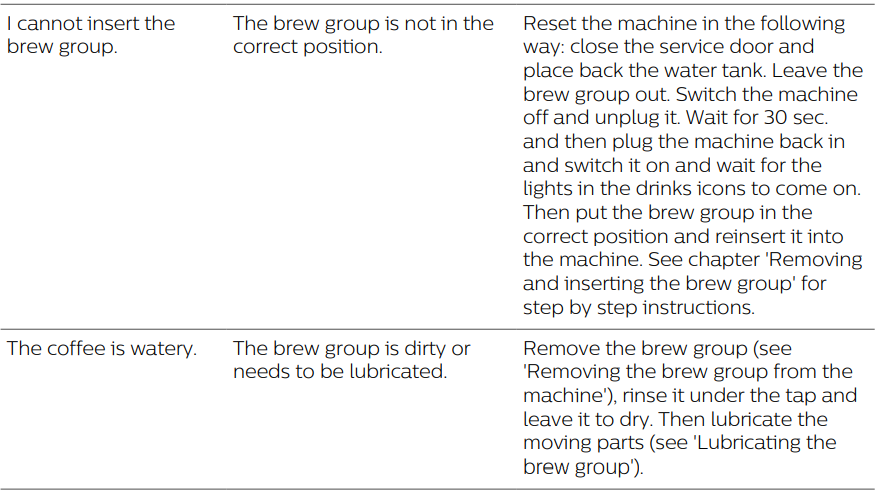
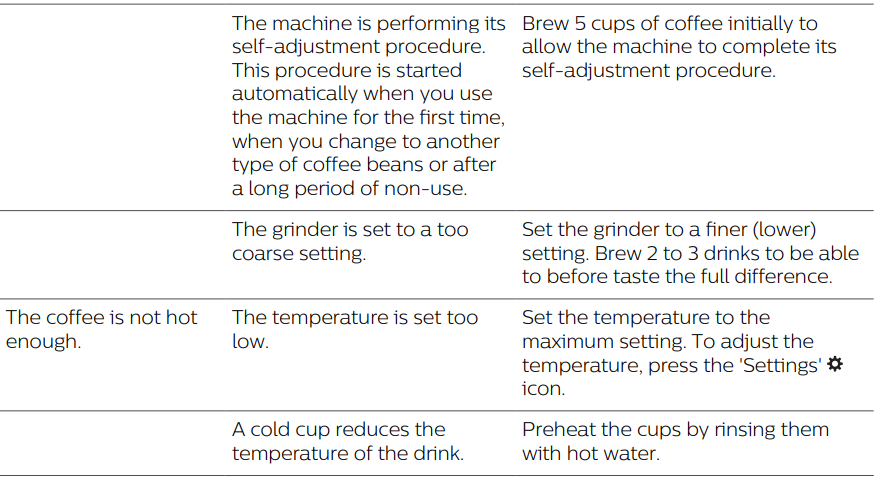

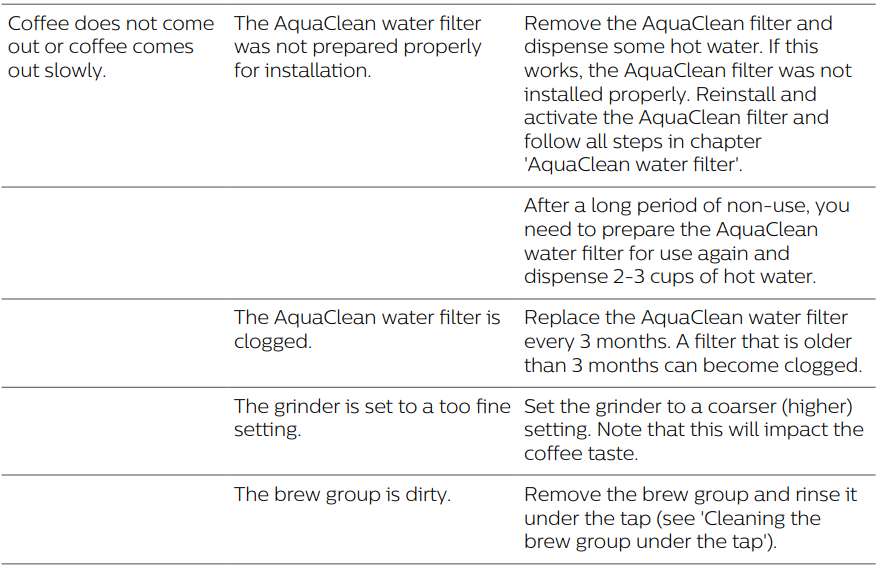
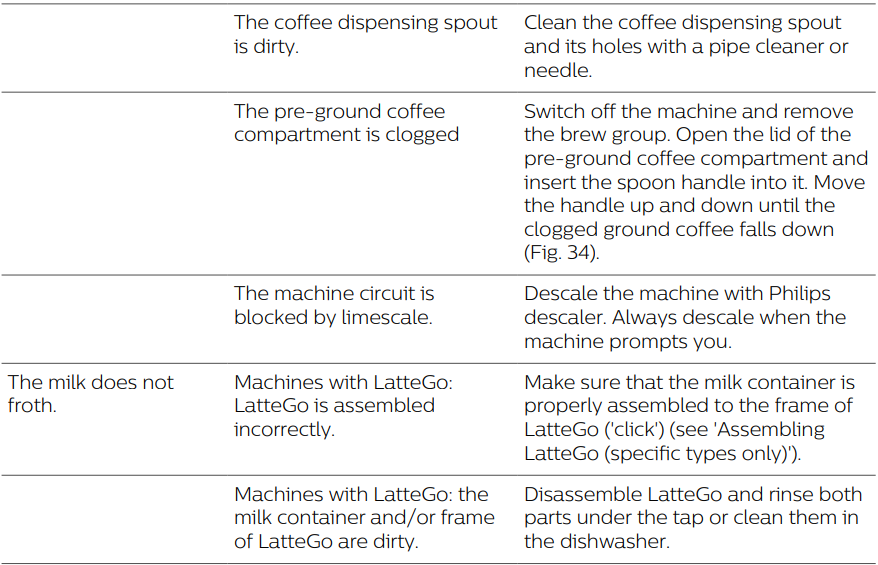
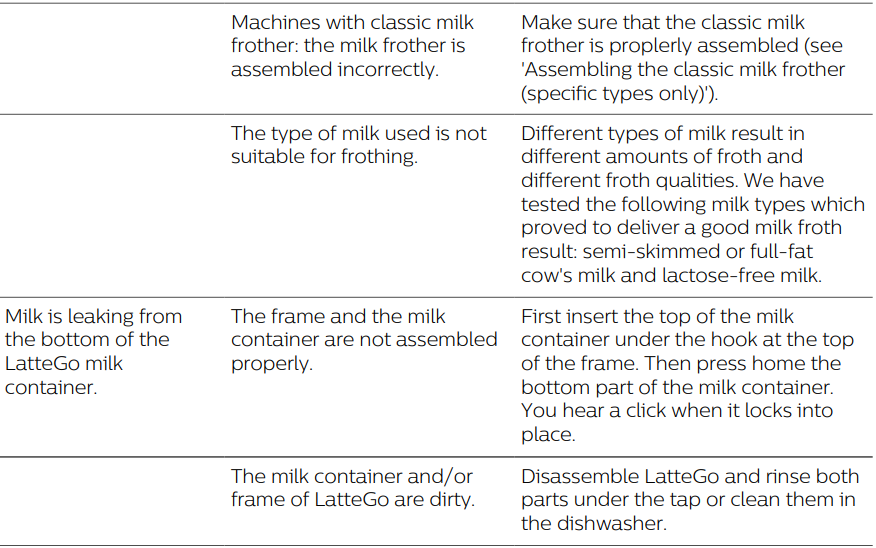
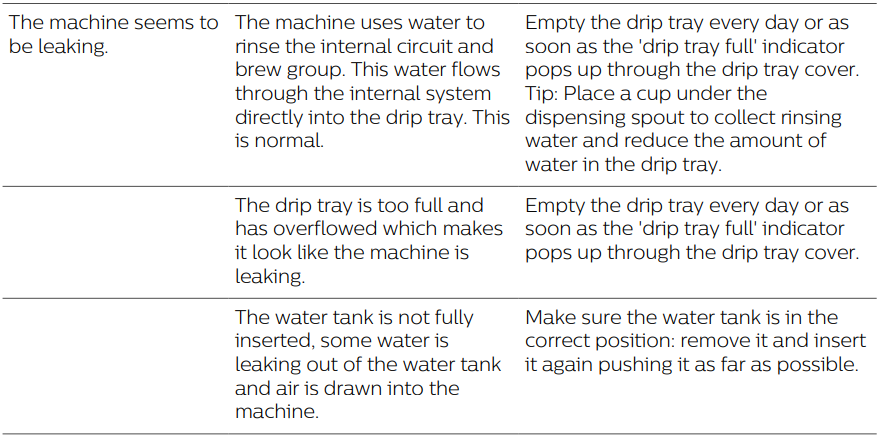


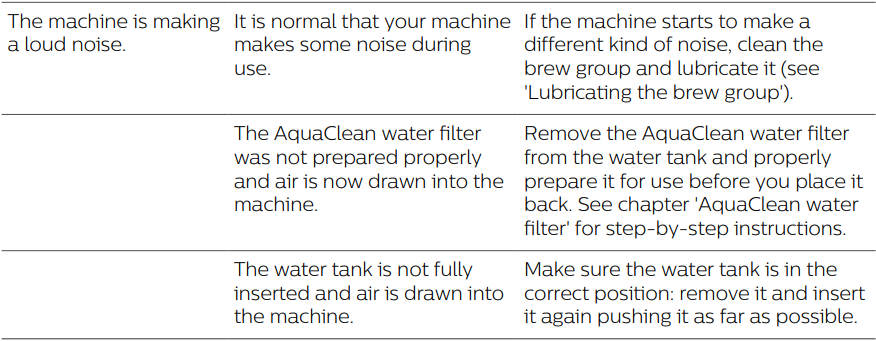
Technical specifications
The manufacturer reserves the right to improve the technical specifications of the product. All the preset quantities are approximate.
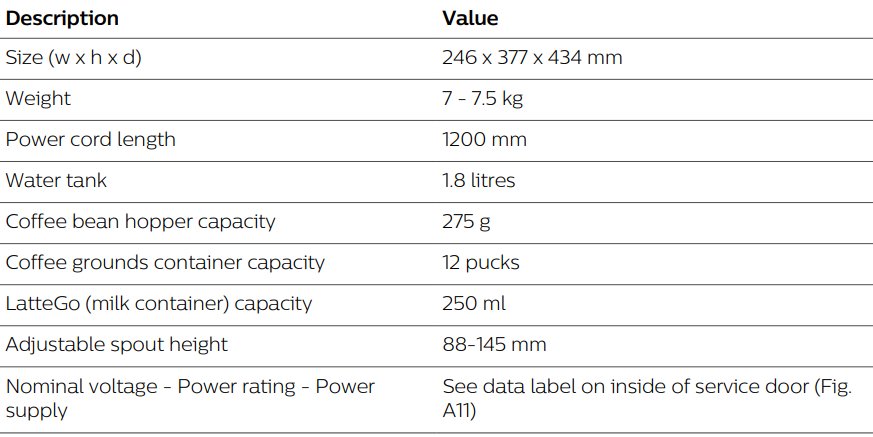
For more manuals by PHILIPS, visit ManualsLibraryy
PHILIPS 4300 Series Fully Automatic Espresso Machine- FAQs
How do I adjust the temperature on my Philips espresso machine?
The Philips 4300 Series automatically heats water to the optimal temperature for espresso extraction. For manual adjustments, refer to the machine’s settings menu (if available) or consult the user manual.
How does an espresso machine work?
Heats water to near-boiling (steam).
Pressurizes steam (9 bars) to force through coffee grounds.
Extracts rich espresso, which condenses into your cup.
How do I adjust drink volume (coffee/milk)?
Fill the water tank with Philips descaler + water up to the “Calc/Clean” mark.
Place a 1.5L container under the spouts.
Press Start/Stop to begin descaling.
Why is my espresso watery?
Grind too coarse? Adjust the grinder to a finer setting (lower number).
Old beans? Use fresh, high-quality coffee beans.
How do I make espresso hotter?
Ensure the machine is preheated (run a blank shot first).
Use preheated cups to retain heat.
What’s the ideal espresso extraction time?
Aim for 25–30 seconds for a balanced shot. Too fast? Adjust to a finer grind. Too slow? Use a coarser grind.
How do I froth milk properly?
Fill a jug with cold milk (up to ⅓ full).
Submerge the steam wand just below the milk surface.
Turn on steam until frothy & silky (~60°C/140°F).
Can I use pre-ground coffee?
Yes! Use the bypass doser for pre-ground coffee instead of whole beans.
Why is my machine leaking water?
Overfilled tank? Don’t exceed the max line.
Tank not seated properly? Reinsert firmly.

